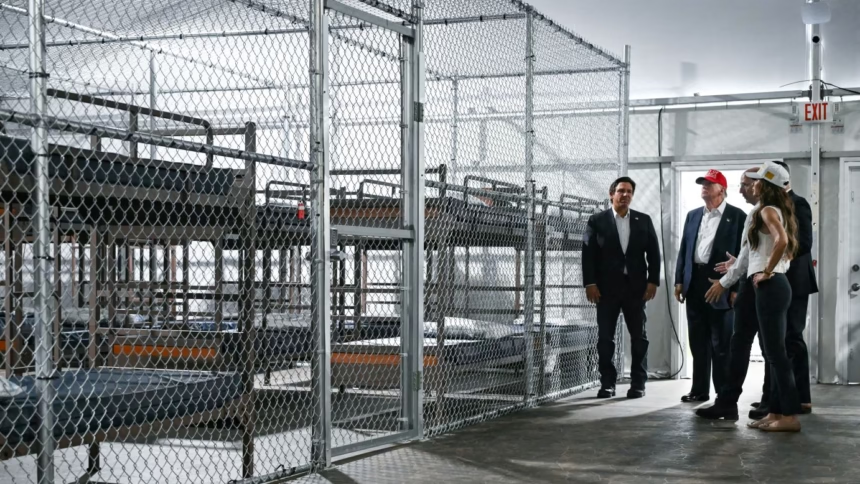The number of detained migrants who are relinquishing their right to pursue immigration court proceedings in favor of accepting “voluntary” departure from the United States has increased dramatically since the summer in the New York and New Jersey jurisdictions.
According to federal data analyzed by Documented, the number of voluntary departures granted to detained individuals has increased by 1,373% compared to the previous year—a jump from 128 cases last year to 1,885 cases during the same three-month period this year in New York and New Jersey.
Attorneys and rights advocates attribute this significant increase not to genuine choice but to a consequence of the Trump administration’s detention policy: restricted access to bail, incarceration conditions described as inhumane, and procedural delays.
A Surge from 128 to 1,885 Departures in Three Months
From July to October 2024, Varick Street and Elizabeth courts granted 128 voluntary departures. In 2025, those months saw 1,885 cases—over fourteen times more—per Executive Office for Immigration Review data.
Nationwide, voluntary departures granted to detainees rose by 363%—from 1,453 cases to 6,716 cases between July and October compared to the same period last year, according to EOIR figures cited by Documented.
This surge comes as the total number of people in immigration detention reaches record levels, with more than 60,000 migrants held in facilities across the country.
A New Bond Policy That Traps People “Without Hope of Getting Out”
The turning point came on July 8, 2025, when U.S. Immigration and Customs Enforcement (ICE) adopted a new interpretation of federal law: individuals who entered without a visa would be presumed ineligible for bond release until the conclusion of their removal proceedings.
Thousands of migrants are now categorically denied even the chance to request a bond hearing. Multiple federal judges have found this policy violates detainees’ due-process rights, but the administration maintains its stance.
For Shayna Kessler, director of the Advancing Universal Representation initiative at the Vera Institute for Justice, this policy directly fuels the explosion of voluntary departures.
Kessler stated, “The increase in voluntary departures is tied to the reduction of due process protections in the immigration system. People are being forced into difficult decisions regarding their families and work,” as told to Documented.
Attorneys indicate that many detainees soon understand they may remain in custody for extended periods without prospects for release. For some, requesting voluntary departure becomes the only option to leave detention, even if it means relinquishing a potential asylum claim.
The “Impossible Choice” of an Ecuadorian Woman
Documented describes a November 10 case: an Ecuadorian woman in her thirties, detained at Delaney Hall in Newark, appears by videoconference before immigration judge Ramin Rastegar. For security, her name is withheld.
After her transfer from New York to New Jersey, she abandons her asylum claim and seeks voluntary departure to Ecuador. The judge says she must fund her own ticket, which she cannot afford.
The judge warns that he must issue a deportation order if she cannot pay and offers her the option to appeal, which would mean several more months in detention. She is clearly distraught facing this choice.
In distress, she abandons her right to appeal to avoid further detention.
Her transfer from New York could have provided access to a free attorney through the New York Family Immigrant Unity Project, which represents New Yorkers detained in New Jersey facilities, but only when attorneys are informed of the transfer.
A Legal “Benefit” at the Cost of Asylum
On paper, voluntary departure is presented as an advantage in immigration law: it allows someone to leave the United States without a formal removal order being issued, thus avoiding, in certain cases, a ban on return of at least ten years.
However, choosing this option requires the person to give up any asylum claim or other form of protection and cover their own travel costs. Immigrant defense organizations highlight the importance of consulting an attorney before making this decision.
In many instances, detainees lack legal representation and may make final decisions about voluntary departure while experiencing extended detention.
Detention Conditions: “They Can’t Take It Anymore”
Conditions in some detention centers also contribute to the increase in voluntary departures. Reports note overcrowding, food shortages, sanitation issues, and limited medical access in several facilities.
Attorney Sharone Schwartz Kaufman, from the Legal Aid Society, believes the combination of mandatory detention and these conditions encourages people to leave at any cost.
“It’s become very difficult because there’s no longer much hope of release,” she explains to Documented. “People are discouraged from staying to seek relief, and that’s also the purpose of this policy.”
Attorney Luke Millar from Legal Aid describes a Venezuelan client, F.J.S., a carpenter from Queens with a strong asylum case—gay, anti-Maduro activist, arrested in 2022, tortured for his orientation, with medical documentation.
Before the new policy, such a case would likely have resulted in release on bond while awaiting a decision. Under the current policy, the individual remained in custody with uncertain prospects for release. Facing worsening conditions—including limited food, sanitation problems, overcrowding, and restrictions after a disturbance—he chose to request voluntary departure during his asylum proceeding.
“For me,” Millar told Documented, “the conditions at Delaney Hall were a significant factor for him.” The attorney also estimated that ICE would have appealed a favorable asylum decision, resulting in additional detention.
In reality, it took an additional 6 weeks after his client’s voluntary departure was granted for him to actually leave the country.
Months in Detention Even After Agreeing to Leave
Attorney Veronica Cardenas, a former ICE counsel, says she has seen clients remain detained up to four months after voluntary departure is granted.
“I wish people knew that,” she says.
Another emblematic case reported by Documented: that of Marlon Garcia Morales, a construction worker living in the Bronx with his partner and their two children. Free for a year and a half while his case progressed, he was arrested leaving a hearing at the 26 Federal Plaza immigration court in Manhattan in July, then placed in a holding area described as frigid and unsanitary.
In a September 17 decision, federal judge Lewis Kaplan found that conditions in this detention facility did not meet constitutional standards and indicated they could influence detainees’ willingness to pursue their defense or seek deportation.
In an affidavit cited by Documented, Garcia Morales summarizes the logic of many detainees: “I decided to be deported because I can no longer bear the detention conditions. I can no longer bear the injustice I have suffered here,” he wrote on July 25. A few days later, he requested and was granted voluntary departure.
Administration Claims “Success,” Advocates Call It Coercion
Neither ICE nor the Department of Homeland Security (DHS) responded to Documented’s questions about this steep increase in voluntary departures. Generally speaking, however, authorities present the high level of “voluntary” returns as proof of the effectiveness of their immigration strategy, consistent with statements by federal officials touting the nationwide rise in self-departures.
Attorneys and organizations argue that the current system has transformed voluntary departure from a limited protective measure into a coercive tool: individuals in challenging conditions and without hope for bond release may relinquish fundamental rights, including asylum, to leave detention.
Shayna Kessler states that the increase in voluntary departures reflects a system where individuals must often choose between their rights and a prompt release from detention. For many migrants, this choice may not feel voluntary.

According to reporting by Paul Moses for Documented.https://ctninfo.com/?p=38335&preview=true
Paul Moses is a professor emeritus of journalism at Brooklyn College and a former reporter and editor at New York Newsday.







